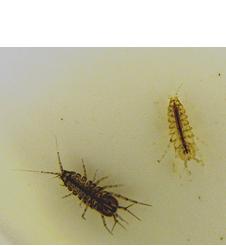Introduction
Evolution is an ever on-going process. One of its driving forces is predation: Predators affect, both directly and indirectly, the composition of the prey community, the prey morphology and their behavior. But as predators do not hunt in the same way they affect the prey in different ways.

The predators
In freshwater habitats the two key groups of predators are fish and invertebrate predators. The two predator groups are dominating in different habitats within a lake: Fish in open water and invertebrate predators in dense macrophyte beds, eg. in the litoral zone.
Generally their hunting strategies are different: Fish search for prey actively and use vision to detect it. They can also pursue it at high speed, should their first attempt fail. Invertebrate predators on the other hand often use "sit-and-wait" as hunting tactics; they ambush their prey. Should they fail to capture it in the first attempt their pursuit speed is not as great as the fish's. The invertebrate predators primarily use tactile cues to detect the prey, but they may also use other means of detection such as vision.
Another difference between predatory fish and predatory invertebrates is the prefered size of prey. Fish prefer large prey, while the invertebrates often are more limited by their gape-size and thus feeds on smaller prey.

The isopods
The aquatic isopod Asellus aquaticus can in some places in Sweden be found as two ecotypes within the same lake.
One of the ecotypes occurs frequently in habitats dominated by emergent vegetation, such as reed ( Phragmites communis ) (from now on the “Reed habitat”) and has a dark pigmentation and is larger than the other ecotype. The other ecotype is common in habitats where submerged vegetation, particularly stoneworts ( Chara spp.), is a dominating bottom substrate. In this habitat, the stonewort habitat, the dominating ecotype is lighter pigmented and is smaller than the reed isopods.
For two Swedish lakes (L. Krankesjön and L. Tåkern) it has been shown that isopods colonizing recently established stands of stonewort change towards the stonewort ecotype over generations. The ecotypic divergence emerge independently in each lake. In both lakes the reed ecotype is the source population for the stonewort ecotype.
The dominating predator is likely to differ in the two habitats; in the reed stands the main predators are invertebrates while the main predators in stonewort stands are fish. In addition to the body-size and the cryptic colouring the ecotypes also have other antipredator adaptations. The reed ecotypes body shape is more adapted to fast movements in water and it has a higher endurance and speed than the stonewort ecotype. In a study of the predator avoidance of the both ecotypes the stonewort ecotype seemed to have lost some of the ability to identify an invertebrate predator as a predator.
Responsible for this page:
Director of undergraduate studies Biology
Last updated:
06/01/11
